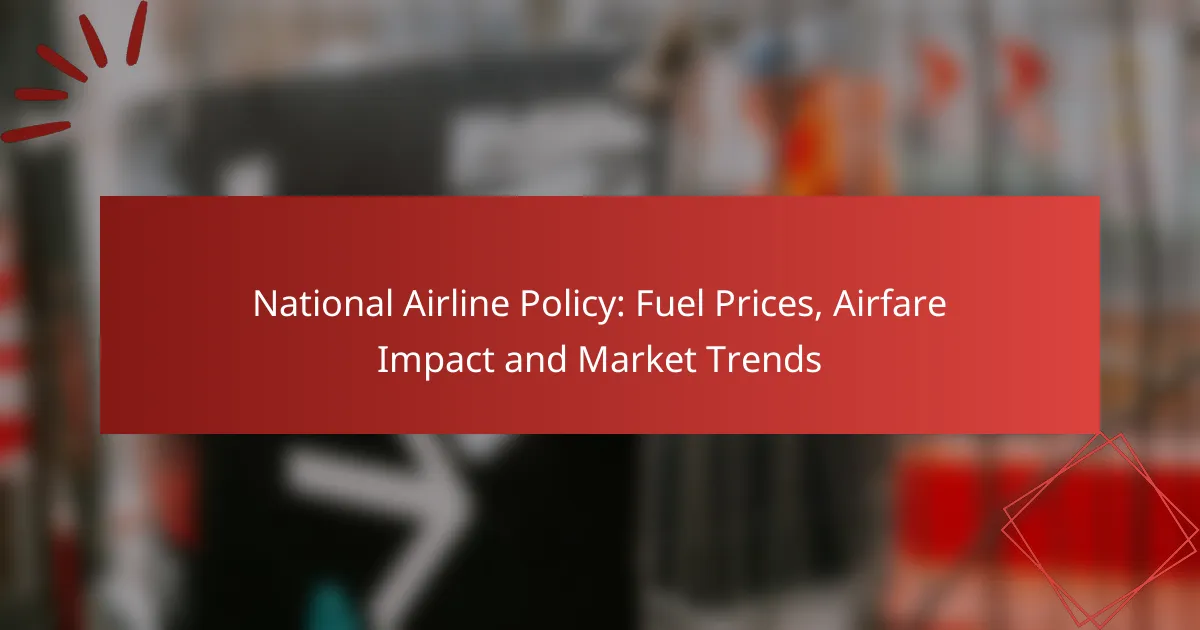The National Airline Policy is intricately linked to fuel prices, which represent a significant portion of airlines’ operating costs. As fuel prices fluctuate, airlines often adjust their ticket prices accordingly, impacting consumers and the overall market dynamics. Understanding these trends is crucial for grasping how operational costs influence airfare and the strategies airlines employ to remain competitive.
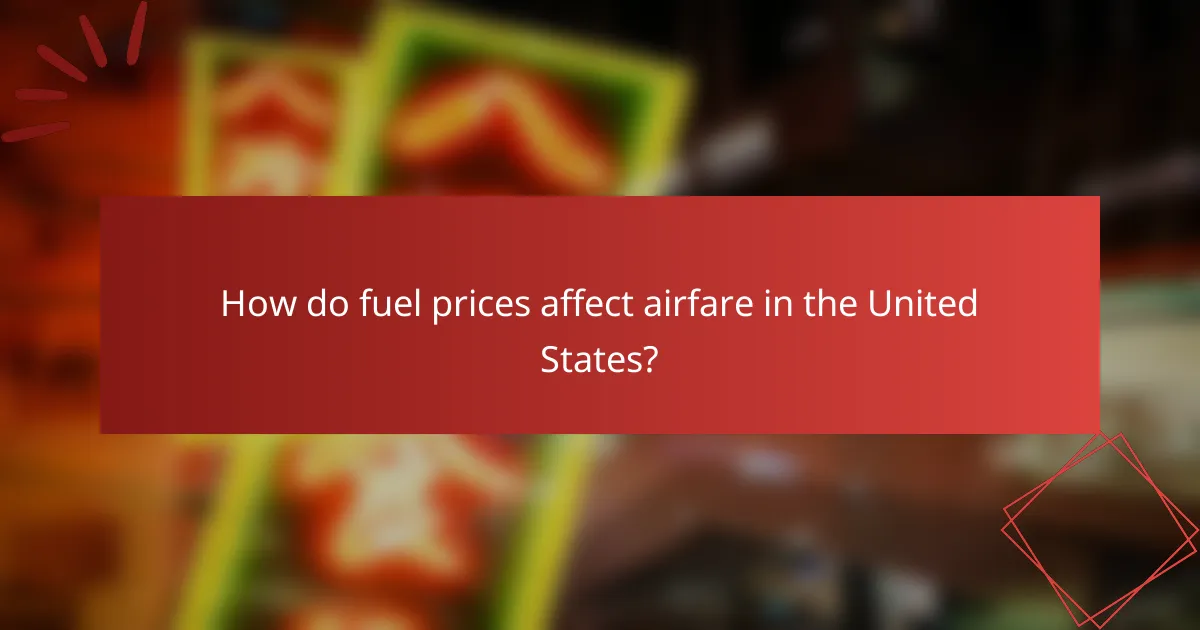
How do fuel prices affect airfare in the United States?
Fuel prices significantly influence airfare in the United States, as they are one of the largest operating costs for airlines. When fuel prices rise, airlines often pass these costs onto consumers through increased ticket prices.
Direct correlation between fuel prices and ticket prices
There is a direct correlation between fuel prices and ticket prices in the airline industry. As fuel costs increase, airlines typically raise fares to maintain profitability. Conversely, when fuel prices drop, airlines may lower ticket prices to attract more passengers.
For example, a rise in crude oil prices by a few dollars per barrel can lead to an increase in airfare by several percentage points. This relationship highlights how sensitive airfare is to fluctuations in fuel costs.
Impact on airline operating costs
Fuel expenses constitute a significant portion of an airline’s operating costs, often accounting for around 20-30% of total expenses. When fuel prices soar, airlines face increased financial pressure, which can lead to cost-cutting measures, including reducing routes or laying off staff.
Additionally, airlines may invest in more fuel-efficient aircraft or implement operational changes to mitigate the impact of rising fuel prices. These strategies aim to balance the need for profitability while maintaining competitive airfare.
Consumer behavior in response to airfare changes
Consumers tend to adjust their travel plans based on airfare fluctuations driven by fuel prices. When ticket prices rise, many travelers may opt for cheaper alternatives, such as driving or postponing their trips. This shift can lead to decreased demand for air travel during periods of high fuel costs.
On the other hand, lower airfare due to reduced fuel prices can stimulate demand, encouraging more people to book flights. Airlines often monitor these trends closely to adjust their pricing strategies accordingly, aiming to maximize occupancy rates while remaining profitable.
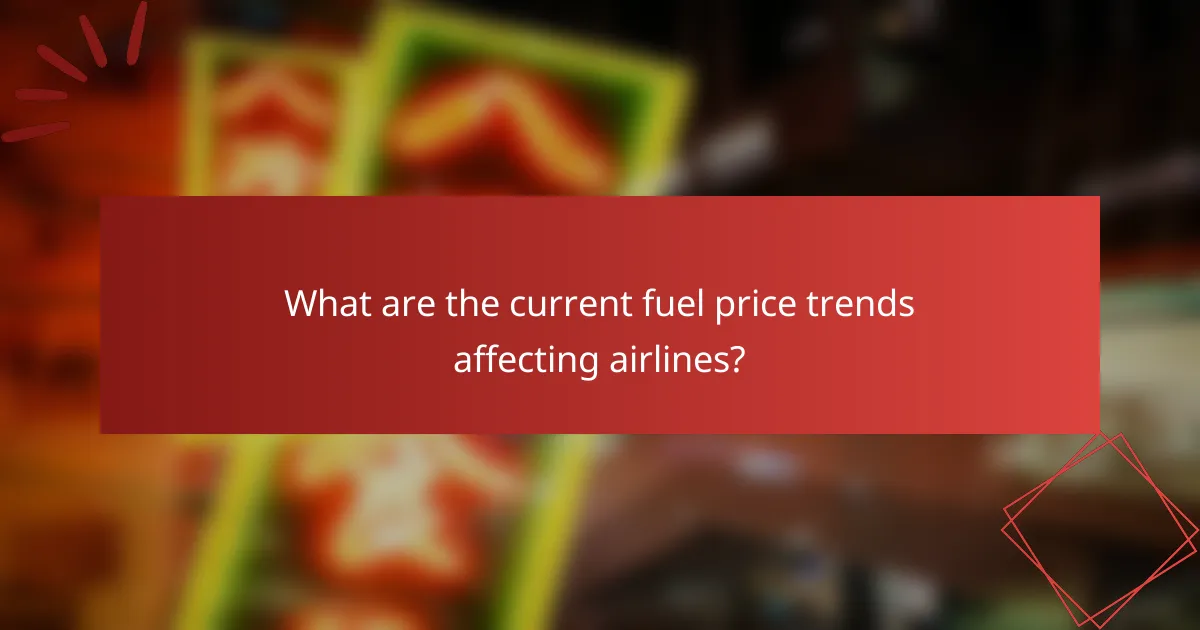
What are the current fuel price trends affecting airlines?
Current fuel price trends significantly impact airlines, influencing operational costs and ticket pricing. As fuel expenses constitute a substantial portion of airline budgets, fluctuations can lead to adjustments in airfare and overall market dynamics.
Recent fluctuations in crude oil prices
Crude oil prices have experienced notable volatility in recent months, often driven by geopolitical tensions, supply chain disruptions, and changes in global demand. For airlines, these fluctuations can translate to increased fuel costs, which may rise or fall by several percent within short periods.
For instance, prices may range from low tens to high tens of USD per barrel, affecting operational budgets. Airlines often hedge against these price changes, but sudden spikes can still impact their financial performance.
Regional variations in fuel costs
Fuel costs vary significantly across regions due to factors such as local taxes, transportation logistics, and refinery capacities. In Europe, for example, fuel prices may be higher due to stringent environmental regulations and taxes compared to regions like the Middle East, where oil production is more abundant and cheaper.
Airlines operating in different regions must account for these variations when setting ticket prices, which can lead to disparities in airfare even for similar routes. Understanding local fuel pricing can help airlines strategize their operations more effectively.
Forecasts for future fuel pricing
Forecasts for future fuel pricing suggest a continued trend of volatility, influenced by ongoing geopolitical developments and shifts in energy policies. Analysts predict that prices could stabilize within a certain range, but unexpected events may still lead to significant fluctuations.
Airlines are advised to monitor these forecasts closely and adjust their pricing strategies accordingly. Implementing flexible pricing models can help mitigate the impact of sudden fuel price changes on profitability.
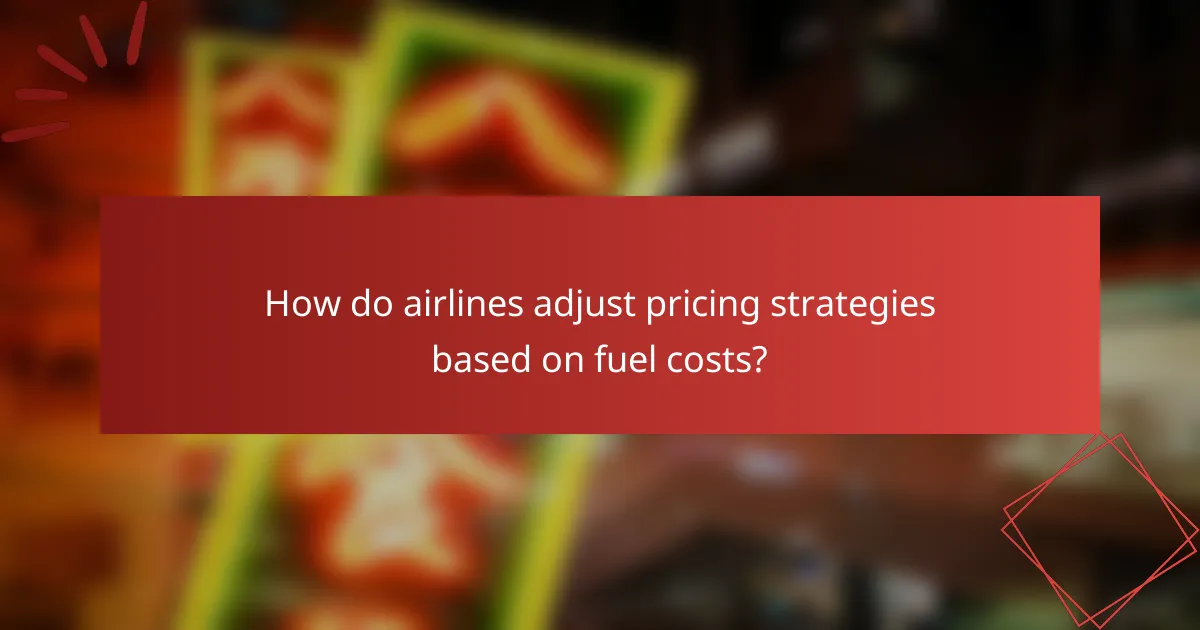
How do airlines adjust pricing strategies based on fuel costs?
Airlines adjust their pricing strategies based on fuel costs by implementing various dynamic models and seasonal adjustments. Fluctuations in fuel prices directly impact operating expenses, prompting airlines to modify fares to maintain profitability while remaining competitive.
Dynamic pricing models
Dynamic pricing models allow airlines to change ticket prices in real-time based on current fuel costs, demand, and market conditions. For instance, when fuel prices rise significantly, airlines may increase fares to offset higher operational costs. Conversely, if fuel prices drop, they might lower fares to attract more customers.
These models often utilize algorithms that analyze booking patterns, competitor pricing, and historical data. This approach ensures that airlines can respond quickly to changes in the market, maximizing revenue opportunities while managing customer expectations.
Seasonal fare adjustments
Airlines frequently adjust fares seasonally to align with travel demand and fuel prices. During peak travel seasons, such as summer or holidays, airlines may raise prices due to increased demand, even if fuel costs are stable. In contrast, during off-peak times, they might lower prices to stimulate bookings.
For example, an airline might offer lower fares in the winter months when travel is typically slower, even if fuel prices are high. This strategy helps balance load factors and revenue throughout the year, ensuring that flights remain profitable.
Promotional strategies during low fuel prices
When fuel prices decrease, airlines often implement promotional strategies to attract more passengers. These promotions can include discounted fares, special deals, or bundled packages that enhance customer value. For instance, an airline might offer a limited-time fare sale to capitalize on lower fuel costs and increase market share.
Additionally, airlines may use marketing campaigns to highlight these promotions, emphasizing savings for travelers. However, it’s crucial for airlines to ensure that these promotions do not compromise overall profitability, as they must balance lower fares with the need to cover operational costs effectively.
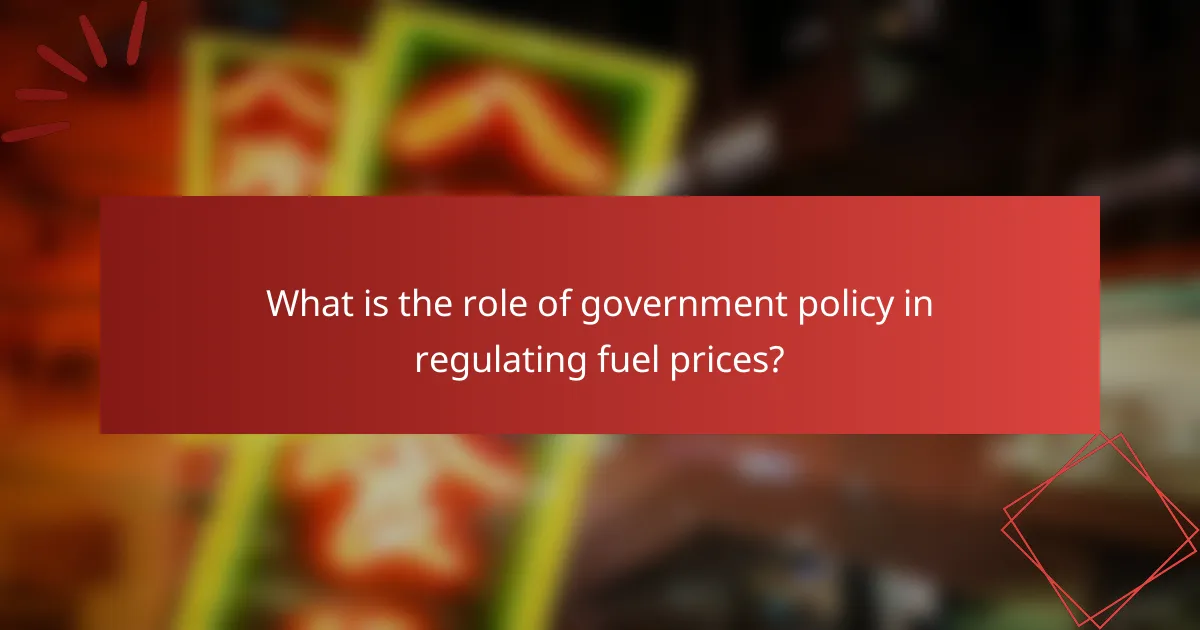
What is the role of government policy in regulating fuel prices?
Government policy plays a crucial role in regulating fuel prices, impacting both the cost of airline operations and ticket prices for consumers. By implementing regulations and subsidies, governments can influence fuel availability and pricing structures, which ultimately affects the airline industry’s financial health.
Federal regulations on fuel pricing
Federal regulations on fuel pricing are designed to ensure fair competition and prevent monopolistic practices. These regulations can include price caps, anti-gouging laws, and oversight on fuel suppliers to maintain stable prices for airlines. For instance, in the United States, the Department of Transportation monitors fuel prices to ensure compliance with federal standards.
Additionally, regulations may vary by country, affecting how airlines manage their fuel costs. In the European Union, for example, regulations may include emissions trading schemes that indirectly influence fuel pricing through environmental compliance costs.
Impact of subsidies on airline operations
Subsidies can significantly impact airline operations by lowering fuel costs, which can lead to reduced airfare for consumers. Governments may provide subsidies to domestic airlines to promote travel and tourism, especially in regions where air travel is essential for economic growth.
However, reliance on subsidies can create market distortions. Airlines that depend heavily on government support may struggle to remain competitive in a deregulated market. It is important for airlines to balance their operations with sustainable practices, ensuring they are not overly reliant on subsidies for profitability.

How do market trends influence airline profitability?
Market trends significantly impact airline profitability by affecting consumer behavior, pricing strategies, and operational costs. Airlines must adapt to fluctuations in demand, competition, and fuel prices to maintain financial health.
Consumer demand trends
Consumer demand trends are shaped by various factors, including economic conditions, travel preferences, and seasonal variations. For instance, during economic upturns, leisure travel often increases, leading to higher ticket sales and potential profitability for airlines.
Airlines can capitalize on these trends by adjusting their routes and pricing strategies. For example, offering promotional fares during peak travel seasons can attract more customers, while maintaining higher prices during off-peak times can maximize revenue.
Competitive landscape among major airlines
The competitive landscape among major airlines plays a crucial role in determining pricing and service offerings. Airlines must constantly monitor their competitors to adjust their strategies, such as introducing new routes or enhancing customer service to attract passengers.
For instance, if a competitor lowers fares on a popular route, other airlines may need to respond with similar pricing or additional incentives, like loyalty programs, to retain market share. Understanding these dynamics is essential for airlines to navigate the market effectively and sustain profitability.
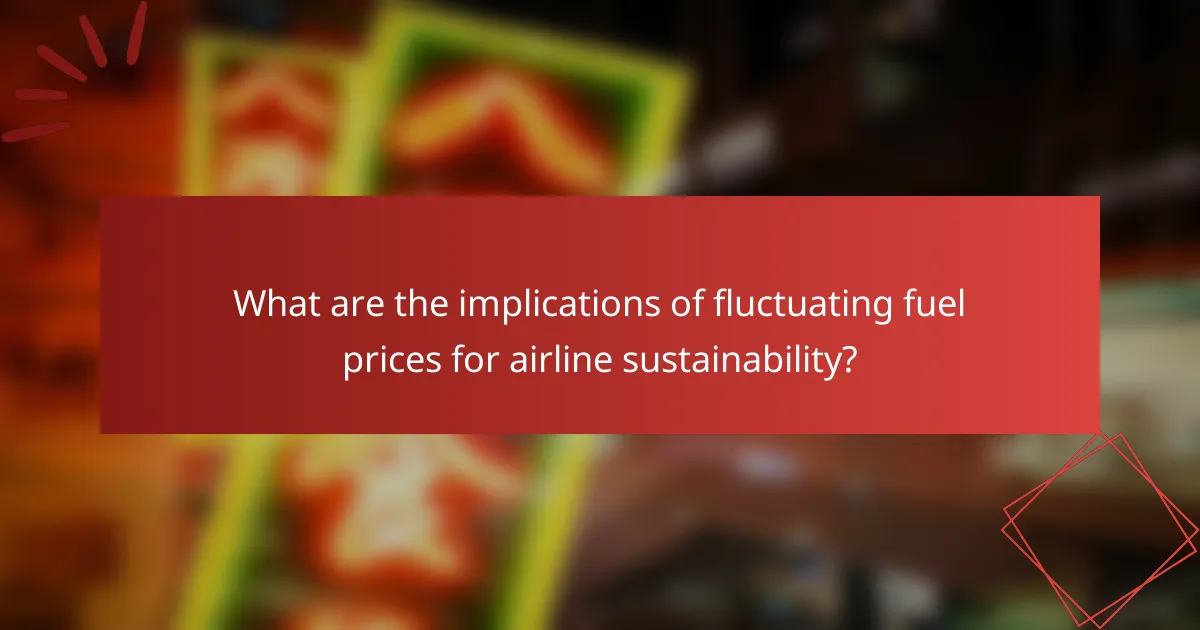
What are the implications of fluctuating fuel prices for airline sustainability?
Fluctuating fuel prices significantly impact airline sustainability by affecting operational costs and pricing strategies. Airlines must adapt to these changes to maintain profitability while striving for environmental responsibility.
Environmental impact considerations
The environmental impact of fluctuating fuel prices is profound, as higher prices can lead airlines to seek more fuel-efficient operations. This often results in a push towards adopting greener technologies and practices, such as investing in newer aircraft that consume less fuel and produce fewer emissions.
Additionally, airlines may implement measures like optimizing flight routes and reducing weight on flights to minimize fuel consumption. These strategies not only help in managing costs but also contribute to lowering the overall carbon footprint of air travel.
Long-term strategies for fuel efficiency
To enhance fuel efficiency, airlines can adopt several long-term strategies. Investing in research and development for sustainable aviation fuels (SAFs) is crucial, as these alternatives can significantly reduce greenhouse gas emissions compared to traditional jet fuels.
Furthermore, airlines should focus on fleet modernization, replacing older aircraft with more efficient models. Implementing advanced flight management systems can also optimize fuel usage during flights, ensuring that airlines remain competitive even in a volatile fuel market.
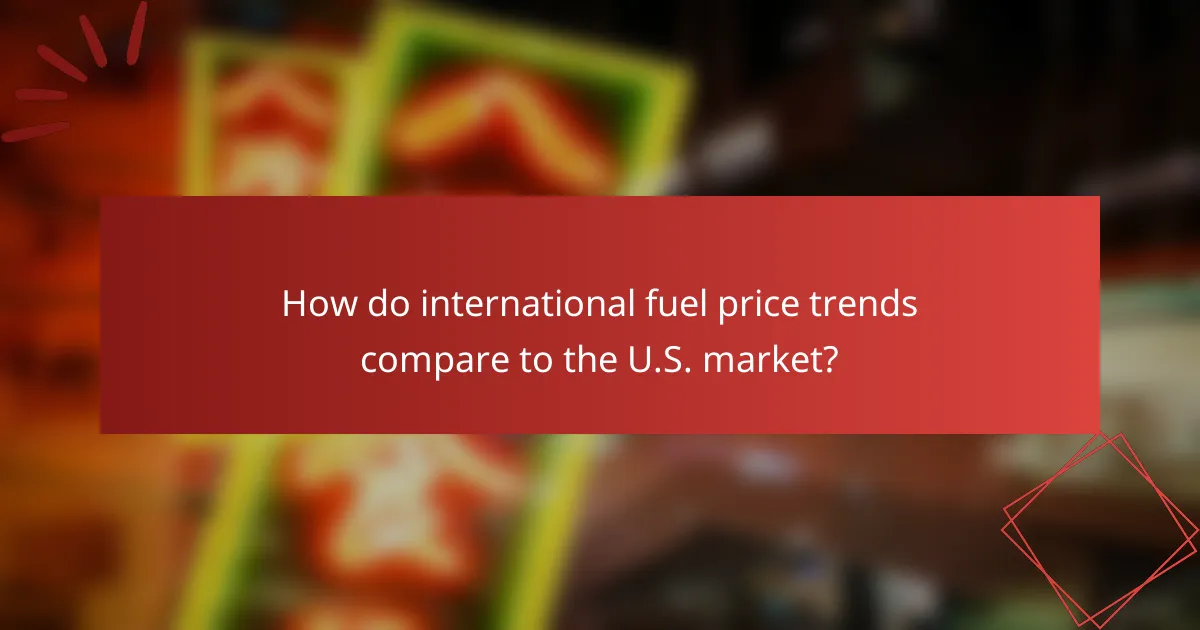
How do international fuel price trends compare to the U.S. market?
International fuel price trends often fluctuate based on geopolitical events, supply chain issues, and market demand, while the U.S. market is influenced by domestic production levels and regulatory policies. Understanding these differences is crucial for airlines and consumers alike, as they directly impact airfare and operational costs.
Global fuel pricing dynamics
Global fuel pricing is affected by various factors including crude oil prices, refining costs, and regional demand. For instance, the Organization of the Petroleum Exporting Countries (OPEC) can influence prices by adjusting production levels. Additionally, currency fluctuations can affect how fuel prices are perceived in different markets.
In regions like Europe, fuel prices tend to be higher due to taxes and environmental regulations, which can significantly impact airline operating costs. Airlines often hedge against fuel price volatility to stabilize their expenses, but this can lead to varying fare structures across different markets.
Comparative analysis of international airfare
Airfare is closely linked to fuel prices, with fluctuations often reflected in ticket costs. For example, when global fuel prices rise, airlines may increase fares to maintain profitability. However, the extent of this increase can vary widely by region and airline, depending on their operational efficiency and pricing strategies.
In the U.S., domestic airfare tends to be more competitive due to a larger number of carriers and routes, which can mitigate the impact of rising fuel costs. Conversely, in markets with fewer airlines, such as certain Asian or African countries, airfare may rise more sharply in response to fuel price increases, leading to less consumer choice and higher costs.
